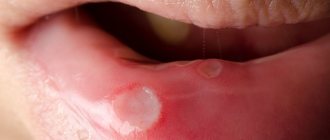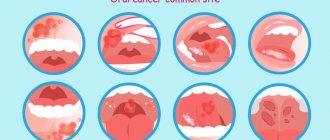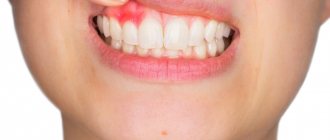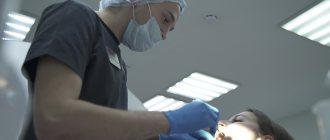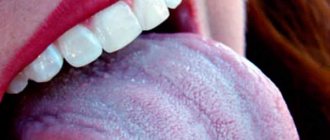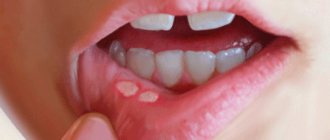In the treatment of cancer, inflammatory processes in the oral mucosa are by no means uncommon, but rather even a pattern, because increased chemical exposure to the body reduces its resistance to infections, most of which enter through the mouth.
In addition, chemotherapy treatment affects the body's cell division mechanism. Due to this, over time, damaged tumor cells become fewer and fewer, but healthy cells are also damaged and for some time lose their natural ability to self-heal. This leads to damage to the epithelial cells that make up the oral mucosa, which, in turn, leads to stomatitis. Due to the drying out of the mucous membrane, small ulcers and cracks appear, and the gums often begin to bleed.
Complications from the digestive system
The most common complications of the digestive system during drug therapy include:
- Nausea and vomiting
- Loose stools (diarrhea)
- Stomatitis
Nausea and vomiting are the leading complaints among patients. The cause of nausea and vomiting is still not completely clear. Chemotherapy is known to cause nausea and vomiting by releasing emetogenic compounds such as dopamine, serotonin and substance P, which act on receptors in the digestive system and central nervous system, triggering the gag reflex. In other words, the development of nausea and vomiting is associated with irritation of receptors in the stomach and brain.
Diagnostics
In most cases, a visual examination by a specialist is sufficient to make a diagnosis. Diagnosis begins with clarification of all symptoms, collection of anamnesis and examination.
The next stage is laboratory research. A scraping is performed from the area affected by the pathology, a blood test is also performed to determine glucose levels and a smear for PCR. These measures are necessary in order to exclude the presence of diabetes in the patient. Laboratory diagnostics also make it possible to assess the degree of the inflammatory process.
Why can our articles be trusted?
We make health information clear, accessible and relevant.
- All articles are checked by practicing doctors.
- We take scientific literature and the latest research as a basis.
- We publish detailed articles that answer all questions.
Also, to undergo a complete diagnosis, a consultation with an allergist is necessary. He prescribes certain tests to determine the presence of allergic reactions to certain substances.
One of the mandatory stages of diagnosis is pharyngoscopy, which allows you to assess the condition of the throat. Gastroscopy is also performed, which helps to detect the presence of degenerative changes in the lining of the stomach.
If necessary, an ultrasound examination of the peritoneal organs may be prescribed. It is carried out if the doctor associates the development of stomatitis with various diseases of the gastrointestinal tract.
Types of nausea and vomiting
The type of nausea and vomiting is determined by the time it occurs during the chemotherapy cycle:
acute - on the first day after the administration of cytostatics
delayed - within 2-5 days after the administration of cytostatics.
With subsequent administrations of the drug, “premature vomiting” (nausea and vomiting “waiting”) may occur - within several hours before the administration of cytostatics. It usually develops in patients who previously received highly emetogenic PCT regimens and suffered from its complications. It can be provoked by smells, tastes, the sight of objects and surroundings reminiscent of treatment. To prevent such nausea and vomiting, tranquilizers, psychotraining, and hypnosis are used.
Unfortunately, often patients may not report the development of complications. This behavior is due to widespread misconceptions about the chemotherapy process, such as:
- “Nausea and vomiting always accompany chemotherapy”
- “The presence of nausea and vomiting indicates the effectiveness of chemotherapy”
- “My chemotherapy will be canceled!”
- “There are no effective treatments for nausea and vomiting”
Some patients downplay the strength and significance of developing complications and do not want to further disturb the medical staff. This behavior greatly impedes constructive interaction between patient and doctor and creates additional health risks.
Recovery Tools
Medicines that reduce the effects of chemotherapy and restore health are prescribed individually for each patient, depending on the diagnosis and the cytostatic agent used. These can be either traditional pharmaceuticals or herbal ones.
Drug therapy is carried out in a hospital setting. Since the liver takes the first blow, it initially needs support. In this situation, the patient takes hepatoprotectors and enterosorbents.
After discharge, the patient is advised to radically change his lifestyle and diet. In most cases, rehabilitation takes about 4-6 months. Experts are developing programs to effectively cleanse the body and protect against attacks by pathogenic flora.
Our experts also recommend taking VIALIFE chlorophyll capsules, which will help minimize side effects in the shortest possible time due to the properties of the maximum possible dosage of chlorophyll in the composition.
Risk factors for developing nausea and vomiting
There are various causes that predispose to nausea and vomiting. First of all, these are the characteristics of the drug used or their combination.
The individual characteristics of the patient are of great importance:
- Age under 50
- Female
- Tendency to motion sickness in transport
- Presence of morning sickness during pregnancy
- Having had nausea and vomiting during a previous chemotherapy cycle
- Rare alcohol consumption
Chemotherapy is most difficult for women and patients under 30 years of age.
Comprehensive monitoring
Laboratory research:
- general blood and urine tests;
- blood biochemistry;
- glycated hemoglobin to track average sugar levels over the past 3 months;
- thyroid profile with indicators of the level of thyroid hormones and specific immunoglobulins;
- insulin check;
- checking the homocysteine value;
- lipid profile with determination of fats of different fractions in blood serum;
- vitamin D content;
- checking the value of the iron-containing protein ferritin.
Consultations with a gynecologist, urologist-andrologist, and dentist are also scheduled. Hardware diagnostics: fluorography of the chest organs, ultrasound. Patients who have crossed the 40-year mark will have to additionally visit the following offices:
- for women - mammography, densitometry (detection of bone fragility);
- for men - ultrasound of the prostate gland, PSA (laboratory marker of the condition of the prostate gland);
- for both sexes - ECG, colonoscopy, coagulogram, duplex scanning of the thickness of the intima-media complex of the carotid artery.
Efficacy of antiemetic therapy
Treating complications of chemotherapy, such as nausea and vomiting, can be beneficial. The arsenal of drugs that provide the prevention and treatment of nausea and vomiting is very large. Their combined use can prevent the appearance of these symptoms in 90% of cases.
Full control: no vomiting after administration of antiemetic drugs,
mild nausea
Partial control: one episode of vomiting or mild nausea
What do I need to know about the side effects of chemotherapy?
The severity of side effects varies greatly from person to person and varies from person to person.
Talk with your doctor about the likelihood of side effects in your case. Your doctor may prescribe medications to help prevent certain side effects before they happen and to help relieve symptoms during treatment. Some chemotherapy drugs cause long-term side effects, such as heart or nerve damage, or fertility problems. However, many people do not have long-term problems with chemotherapy. Although the side effects can be unpleasant, they must be weighed against the need to destroy cancer cells.
From the beginning of chemotherapy treatment, unpleasant symptoms may appear from the first hours of drug administration, continue throughout the entire course and be delayed in time - occurring 2-7 weeks after the end of the chemotherapy course.
After completing the course of treatment, most unpleasant symptoms disappear fairly quickly and only a few of them can be felt for a longer period of time. The recovery time after treatment is very individual.
Lifestyle and nutrition during chemotherapy
Lifestyle and nutrition are of great importance during chemotherapy. Physical activity, fresh air, and breathing exercises are recommended. Physical activity helps to avoid complications.
It is necessary to eat properly - hunger increases nausea. Eating should begin before hunger appears, and you should eat slowly and in small portions.
Other recommendations:
- Avoid eating foods with strong odors
- Avoid fried, fatty and sweet foods
- Food should be at room temperature or chilled
- It is necessary to drink enough liquid, but not during meals
- Try not to cook your own food
- Light, quickly digestible foods are recommended: boiled potatoes, yoghurt, chicken, boiled beef, low-fat broths, rice or oatmeal, crackers.
The effect of chemotherapy on the condition of hair, nails, skin
Chemotherapy affects the condition of your skin, nails and hair, as their cells regenerate quickly and are especially sensitive to chemotherapy.
Hair loss (alopecia) due to chemotherapy occurs after several weeks of treatment. This is a harmless side effect, but it causes a lot of inconvenience.
Remember that this is a temporary side effect; your hair will return 3-6 months after completing chemotherapy.
What to do with alopecia?
- try changing your hairstyle: cut your hair short, shave your head, pick up a wig;
- treat your hair with care (use mild shampoo);
- Protect your head from ultraviolet radiation and strong temperature changes.
The condition of your skin and nails may also change during chemotherapy. Your skin may become particularly dry and flaky, your sensitivity to ultraviolet light may increase, and your nails may begin to yellow and peel.
What to do?
- protect your skin from ultraviolet radiation by using creams and hygienic lipstick with a high protection factor;
- Avoid visiting the solarium and taking hot water baths;
- take good care of hygienic skin and nail care;
- try to shave less to reduce the risk of damaging your skin;
- cut your nails short;
- When washing dishes and cleaning, use protective gloves;
Stomatitis
Stomatitis is an inflammation of the oral cavity that occurs in about a third of patients. Inflammation is most often caused by the activation of bacterial and fungal infections in areas of the mucous membrane damaged by cytostatics. Stomatitis is a manifestation of hidden complications.
Signs of stomatitis:
- "tingling", pain in the mouth
- change in taste
- increased salivation
- redness of the mucous membrane
- the appearance of ulcers
- bleeding gums
- swelling of the tongue and gums
In the absence of timely treatment, severe inflammation, dehydration may develop, and eating will become difficult.
What to do if there is bleeding during chemotherapy treatment?
By attacking bone marrow cells, chemotherapy can reduce the number of platelets in the blood, the cells that are responsible for blood clotting. If chemotherapy drugs affect blood clotting, bruises on the body, frequent nosebleeds, and a small rash on the body may occur.
What to do if there is a risk of bleeding?
- handle cutting objects carefully;
- avoid too vigorous activity, in which there is a risk of bruises and cuts;
- use an electric razor instead of a razor;
- use a soft toothbrush and avoid dental floss;
- Avoid constipation.
Predisposing factors for the development of stomatitis
- Poor oral hygiene (caries, dentures, gingivitis, tonsillitis, etc.)
- Smoking, drinking alcohol
- Spicy, hot, salty food
Prevention of stomatitis includes maximum oral hygiene before starting chemotherapy. Very often, we send patients to the dentist before starting treatment to avoid subsequent complications.
Prevention of stomatitis:
- Assessment of the condition of teeth and mucous membranes before and during treatment
- Complete sanitation of the oral cavity (treatment of caries, use of dental elixirs)
- Careful oral hygiene and diet
Hygiene measures include brushing your teeth with a soft toothbrush, rinsing with a weak solution of hydrogen peroxide, furatsilin, chlorhexidine.
If stomatitis does develop, it is necessary to spare the oral cavity as much as possible when eating - exclude those foods that can cause irritation.
Nutrition for stomatitis:
- Avoid sour fruits and citrus fruits
- Drink up to 1.5 – 2 liters of fluid per day
- We recommend ready-made nutritional formulas for children, cottage cheese, yoghurts, ice cream, soft cheeses, cereals, stewed and steamed beef and poultry, soufflés, puddings
Chemotherapy itself does not impose restrictions on nutrition, but to speed up the restoration of damaged cells, we recommend consuming more protein and generally healthy, nutritious, varied foods.
Treatment of stomatitis:
- Rinsing with warm decoctions of chamomile, sage, oak bark, St. John's wort, soda solution, chicken protein
- Mouth rinse "Tantum-Verde", irrigation with aerosols ("Proposol", "Gexoral")
- Lubricating ulcers with sea buckthorn oil, solcoseryl, actovegin
- Lozenges for resorption (Septolete, Faringosept)
Local treatment is aimed at removing plaque from the oral cavity and maintaining the moisture of the mucous membranes. Anesthesia with local anesthetics (procaine, lidocaine). With the development of esophagitis, antacids, enveloping agents, and antispasmodics are used.
Oral care for children
Children should follow the recommendations in this material. They should also adhere to the recommendations below.
- Use fluoride toothpaste. If your child is 2 years old or younger, consult your dentist or doctor before using fluoride toothpaste.
- If your child's teeth have not yet grown, use a terry cloth, wet wipe, or sponge to clean the gums after meals and before bed.
- If a child has a stable immune system, he should be taken to the dentist every 6 months for routine monitoring.
- Contact Child Life Services to learn how to help your child cope with pain. You can contact them at 833-675-5437 (833-MSK-KIDS).
to come back to the beginning
Symptoms of tooth cancer
Oncology in the initial stages has hidden symptoms and can develop over years and decades. Gradually the symptoms begin to manifest themselves:
- A formation of soft consistency to the touch appears on the jaw, convex in shape, increasing in size over time.
- The dentition may become deformed and the teeth become mobile.
- Pain sensations increase. It becomes difficult for a person to eat, chew, and swallow.
- Regional lymph nodes increase in size.
- A man loses weight.
- Low-grade body temperature, which periodically rises.
- Fistulas in tissues.
- When pressing on the tumor area, the doctor may feel a crunching sound.
- The enamel becomes fragile and is destroyed very easily.
In the prevention of dental cancer symptoms
may not appear, but it is important to visit your doctor regularly. Identified disease in the early stages provides a better prognosis for treatment. Late stages are dangerous for metastasis to other organs.
Kidney disorders
When undergoing chemotherapy, patients may experience side effects that affect kidney function. Chemotherapy may change the color and smell of your urine. Ask your healthcare provider what changes may occur.
If urination becomes difficult, your urine changes color (green, red, orange) or has a strong smell, be sure to tell your doctor about these symptoms.
What to do if you have kidney problems during chemotherapy?
- drink more liquid (at least 40 ml per 1 kilogram of weight) - water, fruit drinks, juices, compotes;
- Avoid drinks that contain caffeine, alcohol, and carbonated drinks.
